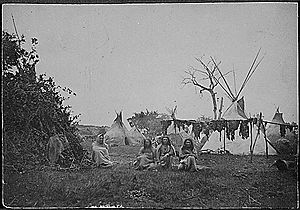Cheyenne facts for kids

The Cheyenne is a Native American nation of the Great Plains. The Cheyenne nation is composed of two united tribes, the Sotaeo'o [no definite translation] and the Tsitsistas, which translates to "Like Hearted People." The name Cheyenne comes from a Sioux word meaning "Little Cree."
Before the Cheyenne were forced to live on a reservation, they were allied with the Arapaho and Lakota (Sioux). They are one of the best-known of the Plains tribes. The Cheyenne nation included ten bands and spread all over the Great Plains, from southern Colorado to the Black Hills in South Dakota. In the mid-1800s, the bands began to split. Some bands chose to remain near the Black Hills, and other bands stayed near the Platte Rivers of central Colorado.
Currently, the Northern Cheyenne live in southeast Montana on their own reservation. The Southern Cheyenne, along with the Southern Arapaho, live in central Oklahoma. Their combined population is approximately 20,000.
Contents
Early History and Culture
Most of what we know about the Cheyenne begins in the mid-1600s. The Cheyenne began to move from the Great Lakes area to what is now Minnesota and North Dakota. There, they established villages with homes made of logs packed with soil and grass. The Cheyenne met the Mandan, Hidatsa, and Arikara nations and adopted many cultural characteristics of these peoples. In 1804, a Cheyenne village was visited by Lewis and Clark during their expedition through North Dakota.
When the Lakota and Ojibwa nations migrated toward them, the Cheyenne began moving further west. By the mid-1800s, many of the Cheyenne had moved into Wyoming, Colorado, and South Dakota. They lived in tipis rather than earth homes; their main diet switched from fish and produce they grew to bison, wild fruits, and wild vegetables.
Anthropologists disagree about how the Cheyenne kept track of their ancestry. Some believe that both parents were considered. Others believe that only the mother's line determined whether or not someone belonged to the Cheyenne tribe.
The government of the Cheyenne bands was different than other nations because they worked together. The central traditional government system of the Cheyenne is known as the "Council of Forty-four." It was named this because there were forty-four seated chiefs on the council. Each of the 10 bands had 4 seated chief delegates, and the remaining 4 chiefs were advisors to the other forty. This system controlled societies that were responsible for warfare planning, enforcing laws and rules, and organizing special ceremonies.
19th Century/Indian Wars
In 1851, the first Cheyenne "territory" was established in northern Colorado. The Fort Laramie Treaty of 1851 gave them territory in the area that now includes the cities of Fort Collins, Denver, and Colorado Springs. Not long after 1851, the Cheyenne lost this land because settlers came for the gold rush.

In the Indian Wars, the Cheyenne were the victims of the Sand Creek Massacre in 1864, in which the Colorado Militia killed 600 Cheyenne. In the early morning on November 27, 1868 the Battle of Washita River started when United States Army Lieutenant Colonel George Armstrong Custer led the 7th U.S. Cavalry in an attack on a band of peaceful Cheyenne legally living on reservation land with Chief Black Kettle. 103 Cheyenne were killed, mostly women and children. Only after the Sand Creek Massacre and Battle of Washita River did the Cheyenne become hostile toward the settlers. The Cheyenne had originally sought peaceful relations with the settlers. The Sand Creek Massacre played an important role in the Indian Wars of the West. As news of the massacre spread, tribes in the area began to prepare for war with the settlers.
The Northern Cheyenne also participated in the Battle of the Little Bighorn, which took place on June 25, 1876. They fought together with the Lakota and Arapaho tribes.
Cultural changes
Over the past four hundred years, the Cheyenne has gone through four stages of culture:
- They lived in the Eastern Woodlands and were a farming people, planting corn, and beans.
- They lived in present-day Minnesota/South Dakota. They continued their farming tradition and also started hunting the bison of the Great Plains.
- They became a full-fledged Plains horse culture tribe.
- They live(d) on reservations.
Interesting facts about the Cheyenne
- In Cheyenne culture, work assignments were based on age and sex.
- They usually placed their villages near rivers so they could trade better.
- The Cheyenne believed the world was divided into seven major levels.
- The bands of Cheyenne would meet for four days each spring for the Sun Dance ceremony.
- Kids enjoyed playing hoop games and lacrosse.
- Cheyenne women wore long deerskin dresses, and men wore breechcloths (a long piece of buckskin that was brought up between the legs and looped over and under the belt at the front and back) with leather leggings.
- Cheyenne artists are famous for their fine quillwork, native beading, pottery, and pipestone carving.
- The Dog Soldiers were the most famous of the Cheyenne warrior societies.
Images for kids
-
Cheyenne hide dress, c. 1920, Gilcrease Museum
-
Cheyenne beaded hide shirt, Woolaroc
-
W. Richard West Jr., former director and co-founder of the Smithsonian's National Museum of the American Indian
-
Cheyenne woman photograph by Edward S. Curtis, 1930
-
Portrait of Cheyenne chief Wolf-on-the-Hill by George Catlin, 1832. A band of Cheyenne visited Fort Pierre, South Dakota in 1832 where some were painted by Catlin during a westward expedition.
-
Ledger drawing of a Cheyenne warrior with pronghorn horned headdress, symbol of the Crazy Dog Society.
-
Little Coyote (Little Wolf) and Morning Star (Dull Knife), chiefs of the Northern Cheyenne
-
White Buffalo, a Northern Cheyenne chief who received the rank of sergeant in the United States Army.
See also
 In Spanish: Cheyenes para niños
In Spanish: Cheyenes para niños
















